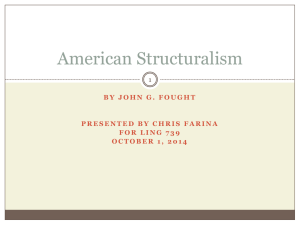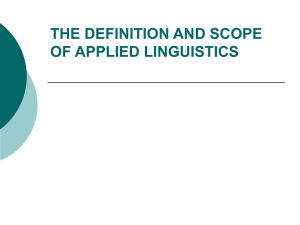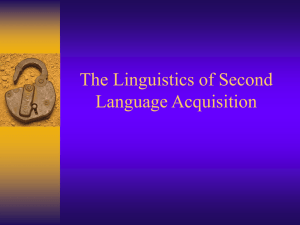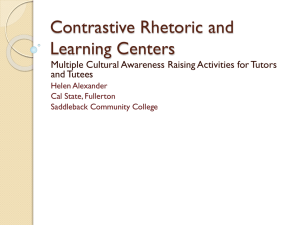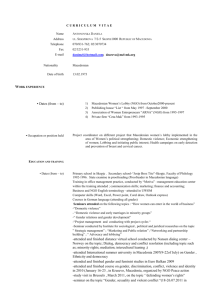translators nouns
advertisement
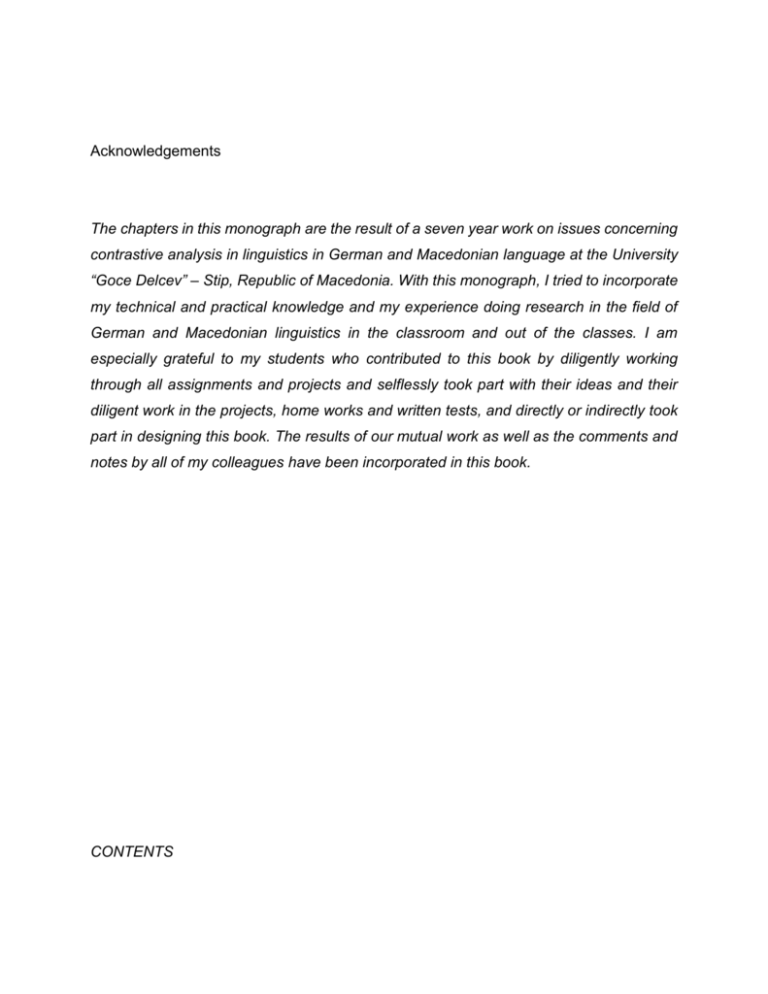
Acknowledgements The chapters in this monograph are the result of a seven year work on issues concerning contrastive analysis in linguistics in German and Macedonian language at the University “Goce Delcev” – Stip, Republic of Macedonia. With this monograph, I tried to incorporate my technical and practical knowledge and my experience doing research in the field of German and Macedonian linguistics in the classroom and out of the classes. I am especially grateful to my students who contributed to this book by diligently working through all assignments and projects and selflessly took part with their ideas and their diligent work in the projects, home works and written tests, and directly or indirectly took part in designing this book. The results of our mutual work as well as the comments and notes by all of my colleagues have been incorporated in this book. CONTENTS I. Acknowledgment………………………………………………………………4 II. Preface …………………………………………….……………………………5 1. Introduction………………………………………………………………………….6 2. The contrastive analysis and its relation to foreign language teaching………7 3. Determiners in German and Macedonian………………………………………11 4. Determines in German .………………………………………………………….12 5. Definiteness in Macedonian …………………………………………………….20 6. Determines vs. Gender in the language par German-Macedonian………….22 7. Recent research…………………………………………………………………..28 8. Methodology and procedures……………………………………………………30 9. Cross-linguistic differences………………………………………………………36 10. Summary and conclusion remarks ……………….…………………………….41 11. References…………………………………………………………………………42 12. Abbreviations………………………………………………………………………47 13. Glossary ……………………………………………………………………………50 Preface 1 The monograph The category of definiteness in the language pair German and Macedonian was prepared with the following objectives in mind: 1. To raise foreign language students’ awareness of the differences in the language pair German-Macedonian and to point out the similarities between German and Macedonian language in the field of definiteness. 2. To train teachers and foreign language students how to apply contrastive analysis in their teaching and learning German as a foreign language (DaF-Deutsch als Fremdsprache). 3. To train teacher training students and translator students how to apply contrastive analysis in their future teaching and translation work. This monograph focuses on differences and similarities between German and Macedonian linguistics. It covers the following topics: -The first part of this monograph describes the research topic of the contrastive linguistics and the contrastive analysis, its historical development, its relationship with other linguistic disciplines and the role of the mother tongue (transfer) in acquiring a foreign language. -The next section deals with the topic on definiteness in Macedonian language as a Slavic language, and how it is expressed in German, tracing the similarities and differences between the two languages. The topics discussed touch issues in the fields of morphology, lexicology, syntax, and pragmatics. 2 Contrastive analysis of German and Macedonian is relevant for both foreign language students, teachers, translators and multiplicators of German language in Macedonia. For foreign language students it offers possibilities about principles of acquiring a foreign language, for teachers, it offers explanations about the language behavior of their students; for translators, it offers opportunity to explore different translation options, thus developing their sensitivity to language issues. The aim of the activities is to help students work through the chapters and get acquainted with the main terminology required to become independent readers in the field. It also provides ideas for small-scale research to introduce students to the techniques and different instruments to conduct research on contrasting German and Macedonian. 1. Introduction I come from Macedonia, a small country with a long name, which has always been a traditional center of mutual meetings and agreements, communication and co-existence of the people on the Balkan Peninsula, as well as one of the most dynamic regions where many of the socio-economic activities in South-East Europe and wider developed. Macedonia is a multilingual, multiethnic, and multicultural country and long time ago it was the scene of many wars and conflicts and thus was the subject of attacks, which were sometimes solved with military and sometimes with diplomatic means. Today, the official languages in the Republic of Macedonia is the Macedonian language. The Macedonian language belongs to the South Slavic languages and is spoken by 2-3 million people who live in the country and in the diaspora (especially in Albania, Bulgaria, Greece, Serbia, the USA, Australia and Canada). On the other hand, the Albanian language belongs to the Indo-European languages and does not belong to any other existing branch. In Macedonia people generally speak two or more than two languages (Macedonian/Albanian or Turkish) or even three languages /Xhaferi, B. & Xhaferi, G., 2012/. The modern standard written version of Macedonian appeared in 1945. Since then many literary works have been published in Macedonian. Literary Macedonian is based 3 on the dialects of the west central region (Prilep, Kičevo, Bitola, Kruševo and Lerin). (Kostadinovska-Daskalovska K. 2005). The structure of this paper is as follows: section 1 discusses relevant data about the contrastive linguistics and contrastive analysis; section 2 describes the determiners in German language and the previous research on articles in this language system. The next section presents the representative information about the definiteness in Macedonian language system and how it is actualized in this language system. The methodology of the received results is presented in the next section, followed by the results and concluding remarks of our analysis in the following section. In the present study we try to analyze when the Macedonian speakers of German use the definite, the indefinite or null articles, and what these articles mean in the context of the utterance or in the sentence. I investigate the choice of an article and article omission in the second language (L2) acquisition of German of native speakers of Macedonian (a language with postfixed articles), who have previously acquired English to different levels of proficiency. This paper discusses determiner production in the data from the students whose first language (L1) is Macedonian, and were admitted as students of German as a foreign language at the Faculty of Philology; they were all at the age of 18-22, during their studies in GFL1. Various studies of adults learners of a second language (L2) with article have found that determiner omission and incorrect article use are quite common and persistent among learners who speak GFS. In the present study, the L2 learners are adults, e.g. students of German language, e.g. students of German as a foreign language (DaFstudents). 1 GFL-German as a foreign language – students (DaF-students) 4 2. The contrastive analysis (CA) and its relation to foreign language teaching The program of "contrastive linguistics" in the narrow sense of the word was formulated in the sixties and seventies of the last century with the aim of systematic inclusion of similarities and contrasts between native language and the foreign one, to predict the learning difficulties in acquiring foreign language and to develop teaching materials and teaching strategies based on the acquired knowledge, as well as to make the teaching of foreign languages effectively (see Lado 1957; Nickel, 1971; Aarts 1981 Alatis 1968). After a few years of enthusiastic work and implementation of this program, the contrastive linguistics was rather a modest marginal branch within the comparative linguistics and only in recent years was known under different names, such as bilingual language comparison, comparative grammar, microscopic typology. Three reasons were, are to be responsible for this disillusionment: A) The contrastive linguistics, upon which statements about contrasts and learning difficulties and strategies of teaching were central themes and elements seen in the theory of second language acquisition and thus with these unrealistic expectations has disappointed sooner or later the grammarians. (B) In the creation of the descriptive bases of the study, i.e. in creating comprehensive comparative grammars for relevant language pairs, only few convincing studies have been made. More comprehensive studies on the English and German (Kufner 1962) contained for the most part well-known, basic observations, comprehensive contrastive studies on the German and Slavic and other languages were missing then completely. (C) The positioning of contrastive linguistics in the context of comparative linguistics is missing, it is not clear what the possibilities and limitations of this type of language comparison are. 5 According to Volker Gast (2011), the contrastive analysis (CA), narrowly defined, investigates the differences between pairs (or small sets) of languages against the background of similarities and with the purpose of providing input to applied disciplines such as foreign language teaching and translation studies. With its largely descriptive focus contrastive linguistics provides an interface between theory and application. It makes use of theoretical findings and models of language description but is driven by the objective of applicability. Contrastive studies mostly deal with the comparison of languages that are ‘socio-culturally linked’, i.e. languages whose speech communities overlap in some way, typically through (natural or instructed) bilingualism. The contrastive linguistics (analysis) is based on a behaviorist conception of language acquisition, insofar as it is based on the assumption that foreign language learners constantly resort to the “habits” they acquired in the process of first language acquisition: “The basic problems [when learning a second language] arise not out of any essential difficulty in the features of the new language themselves but primarily out of the special 'set' created by the first language habits.” (Charles C. Fries in: Lado 1957) In later research, CL has been linked to aspects of applied linguistics, e.g., to avoid interference errors in foreign-language learning, to assist interlingual transfer in the process of translating texts from one language into another, and to find lexical equivalents in the process of compiling bilingual dictionaries. This involved describing the languages (using structural linguistics), comparing them and predicting learning difficulties. Contrastive descriptions can occur at every level of linguistic structure: speech sounds (phonology), written symbols (graphology), word-formation (morphology), word meaning (lexicology), collocation (phraseology), sentence structure (syntax) and complete discourse (textology). Various techniques used in corpus linguistics have been shown to be relevant in intralingual and interlingual contrastive studies, e.g. by 'parallel-text' analysis. Contrastive linguistic studies can also be applied to the differential description 6 of one or more varieties within a language, such as styles (contrastive rhetoric), dialects, registers or terminologies of technical genres. The grammars of the Contrastive Structure Series as many of the early contrastive studies were concerned with major areas of ‘core grammar’, in particular phonology and syntax, a number of more specific studies were published in the 1970s and 1980s (e.g. König 1971, Rohdenburg 1974, Plank 1984). These studies were characterized by more specific topics and they had an increasingly theoretical orientation. Applicability in second language acquisition was a desirable, yet secondary aim, and the focus was shifted to the more abstract question of why languages differ in the way they do. This epistemological objective was closely related to the programme of linguistic typology, and contrastive linguistics came to be regarded as a “limiting case of typological comparison” (cf. König 1992, 1996, forthcoming), or a “junior partner” of linguistic typology (Kortmann 1996). While in linguistic typology many languages are compared with respect to a single variant property, contrastive studies compare only two (or very few) languages, but take a broad range of phenomena into account, ideally all areas of grammar. Even though the distinction made by Fisiak (1971, 1981), among others, between ‘theoretical’ and ‘applied’ contrastive analysis is probably not categorical, it provides a useful dichotomy for the characterization of the main objectives pursued by contrastive linguists. The typologically inspired research as sketched above is certainly located towards the theoretical pole of the continuum, but it has been shown to be not entirely irrelevant to language teaching (cf. Mair 2005 on ‘spin-offs for language teachers’). For example, the typological notion of ‘markedness’ has played an important role in research on language acquisition (cf. Kortmann 1996, James 2005), and ‘typological distance’ has been claimed to correlate with difficulty of learning (cf. Kortmann 1996, referring to Schachter 1974 on the acquisition of relative clauses). We consider the contrastive analysis (CA) as an linguistic approach which aim is to describe the differences and similarities between two languages. In this paper we examine the language pair German-Macedonian and try to find similarities and 7 differences in the field of definiteness. Krzeszowski (1990) defining the contrastive analysis writes: XXXXXXXXXXXXXXXXXXXXXXXXXXXXXXXXXXXXXXXXXXXX 3. Recent research The contrastive approach has also been beneficial in analyzing the problem of articles and definiteness. Chesterman’s work On definiteness. A study with special reference to English and Finnish (1991) compares English as an article-possessing language with Finnish, which has no articles. Chesterman’s publication can at the same time be used as a valuable source of information on contrastive studies of definiteness for a number of other languages such as Wexler’s (1976) work which compares Russian with Finnish, and works by Orosz (1969) and Stephanides (1974) on the article in English and Hungarian. Szwedek’s work Word order, sentence stress and reference in English and Polish (1976) compares English and Polish. The German tradition of contrastive article studies is represented by H. J. Grimm and his Einige Probleme bei der Konfrontation des deutschen Artikels mit bestimmten Ausdruckmitteln artikelloser slawischer Sprachen (1983) and by W. Birkenmaier’s Artikelfunktionen in einer artikellosen Sprache (1979). The concern of both studies is a comparison of German as an article-possessing language with articleless Slavonic languages (mostly Russian and Polish). Hais (1991, 42) admits that a satisfactory theoretical explanation of the category of definiteness in English has not been formulated so far. Such a claim must, in my opinion, also apply to an explanation of articles. Chesterman (1991, 63) sees the explanation of articles as a problem. He lists several problematic areas which make it difficult for a “unified description of the English articles” to be formulated. I summarise Chesterman’s points under the following two items: 1. classification of articles 2. the amount of articles. A simple definition of articles may say that articles are words which determine the noun and convey information about its definiteness/indefiniteness. At the first sight, this definition seems to apply to Macedonian as well as to German articles. But if articles are examined more thoroughly, it becomes clear that such a definition is insufficient. 8 At least two data sets with German as an L3 have been recently analysed. Jaensch (2008, 2009) studied data that bear on a number of determiner phrase (DP) features in German, including the acquisition of definiteness, suppliance and infection of articles and number marking on nouns and gender assingement. Jeansch (2008) discusses the acquisition of German adjectival inflection in the light of the prosodic transfer Hypothesis (Goad, White & Steele 2003) and the missing surface inflection Hypothesis (Prėvost & White 2000) and conclude that there was stronger support for the later explanation. XXXXXXXXXXXXXXX References: Flämig W. (1991): Einführung in Struktur-und Wirkungszusammenhänge ; Erarbeitet auf der theoretischen Grundlage der ,,Grundzüge einer deutschen Grammatik Akademie Verlag, 1991 - Foreign Language Study - 640 pages. Friedman, V. (2001): Macedonian. SEELRC 2001. http://www.seelrc.org:8080/grammar/ mainframe.jsp?nLanguageID=3 Gast, V. (forthcoming). Contrastive analysis: Theories and methods. In Kortmann, B. and J. Kabatek (eds.), Dictionaries of Linguistics and Communication Science: Linguistic theory and methodology. Berlin: Mouton de Gruyter. Gass, S. & Larry S.(1994): Second Language Acquisition: An Introductory Course. New Jersey: Lawrence Erlbaum Associates, Inc. Gast, V. & D. Wiechmann (2011): W(h)-clefts im Deutschen und Englischen. Eine quantitative Untersuchung auf Grundlage des Europarl-Korpus. In Gunkel, L. and G. Zifonun (eds.) Jahrbuch des IDS 2011. Berlin: de Gruyter Mouton. Gass, S. and L. Selinker (1983): Language Transfer in Language Learning. Rowley, MA: Newbury House. Gómez-González, María de los Ángeles & Susana M. Doval-Suárez. (2003): On Contrastive Linguistics: Trends, Challenges and Problems. In Butler, Christopher S. et al (Eds). Dynamics of Language Use: Functional and Contrastive Perspectives. (pp. 19-47) Philadelphia, PA, USA: John Benjamins Publishing Company. Granger, S. (2002): A Bird’s-eye view of learner corpus research. In Granger, Sylviane Hung, Joseph, and Petch-Tyson, Stephanie (Eds). Computer Learner Corpora, Second Language Acquisition and Foreign Language Teaching. Philadelphia, PA, USA: John Benjamins Publishing Company. Grimm H.-J. (1983): Einige Probleme bei der Konfrontation des deutschen Artikels mit bestimmten Ausdrucksmitteln artikelloser slawischer Sprachen. In: Helbig et al. Hg. 1983. in: DaF 5/1979, S. 273. Hawkins, J. (1986): A Comparative Typology of English and German: Unifying the Contrasts. London: Croom Helm. Hawkins, J. (1992). A performance approach to English/German contrasts. Im Mair and Markus, 115—136. 9 Hais, K. & Hodek, B. (1991): Velky angličko-cesky Slovnik. II T-Z. Academia Praha. Hawkins, J. (1994): A Performance Theory of Order and Constituency. Cambridge: Cambridge University Press. Hawkins, J. (2004): Efficiency and Complexity in Grammars. Oxford: Oxford University Press. Hellinger, M. & U. Ammon (1996). Contrastive Sociolinguistics. Berlin: Mouton de Gruyter. Helbig, G. & Buscha, J.(1994): Deutsche Grammatik. Ein Handbuch für den Ausländerunterricht. Nachdruck. Berlin usw.: Langenscheidt. Ionin, T., H. Ko and K. Wexler (2004): Specificity as a Grammatical Notion: Evidence from L2English Article Use. In G. Garding and M. Tsujimura, eds., Proceedings of the 22nd West Coast Conference on Formal Linguistics, Cascadilla Press, Somerville, MA, 245-258. James, C. (1980): Contrastive Analysis. London: Longman. James, C. (2005): Contrastive analysis and the language learner. In David J. Allerton, Cornelia Tschichold, and Judith Wieser (eds.), Linguistics, Language Teaching and Language Learning, 1–20 Basel: Schwabe. Jaensch, C. (2008): L3 Acquisition of articles in German by native Japanese speakers. In: Proceedings of the 9th generative approaches to Second Language Acquisition Conference (GASLA 2007), ed. Roumyana Slabakova et al., 81-89. Somerville, MA: Cascadilla Proceedings Project. Jaensch, C. (2009): Article choice and article omission in the L3 German of native speakers of Japanese with L2 English. In: Second language acquisition of articles: Empirical findings and theoretical implications, edited by M. d. P. García-Mayo and R. Hawkins. Amsterdam: John Benjamins, p. 233-263. Kepeski, K. (1978): Gramatika na makedosnkiot literaturen jazik za učilistata za sredno obrazovanie. Skopje. Koneski, B. (1967): Gramatika na makedosnkiot literaturen jazik, I del; II del, Skopje: Kultura. (Combines Part 1 (revised) 1957 and Part 2 1954.). Kostadinova-Daskalovska, K. (2005): Census of Population, Households and Dwellings in the Republic of Macedonia, 2002 . The state statistical office. Skopje. R. Macedonia König, E. & V. Gast (2009): Understanding English-German Contrasts. 2nd ed. Berlin: Erich Schmidt Verlag. König, E. (1971): Adjectival Constructions in English and German. A Contrastive Analysis. Heidelberg: Julius Groos. König, E. (2012): Contrastive linguistics and language comparison. Languages in Contrast, 12:1, 3–26. König, E. (1992): Contrastive linguistics and language typology. In Mair & Markus, 137–154. König, E. (1996): Kontrastive Grammatik und Typologie. In Lang, E. and G. Zifonun (eds.), Deutsch – typologisch. Berlin 6 New York: Mouton de Gruyter. König, E. (forthcoming). The place of contrastive linguistics in language comparison. Languages in Contrast. 10 Kortmann, B. (1996): Kontrastive Linguistik und Fremdsprachunterricht. In Börner, W. and K. Vogel (eds.), Kontrast und Äquivalenz. Beiträge zu Sprachvergleich und Übresetzung, 136—167. Tübingen: Narr. Kortmann, B. and P.G. Meyer (1992): Is English grammar more explicit than German grammar after all? In Mair and Markus, 155–166. Krzeszowski, T. (1990): Contrasting Languages: The Scope of Contrastive Linguistics. New York, NY: Mouton de Gruyter. Kufner, H.L. (1962): The Grammatical Structures of English and German. Chicago: University of Chicago Press. Lado, R. (1957): Linguistics across Cultures. Ann Arbor: University of Michigan Press. Leung, C. (2005): Convivial communication: Recontextualizing communicative competence, International Journal of Applied Linguistics, 15 (2): 119–44. Lunt , G. H. (1978): Grammar of the Macedonian literary language. Skopje. Mair, C. (1990): A contrastive analysis of object control in English and German. Papers and Studies in Contrastive Linguistics 25: 85-101. Mair, C. and M. Markus (1992): New Departures in Contrastive Linguistics. Innsbruck: University of Innsbruck Press. Moulton, W.G. (1962). The Sounds of English and German. Chicago: University of Chicago Press. Mair, C. (2005): Recent Advances in Contrastive Linguistics and Language Typology: The SpinOff for Language Teachers. In David J. Allerton, Cornelia Tschichold, and Judith Wieser (eds.), Linguistics, Language Teaching and Language Learning, 21–39 Basel: Schwabe. Naylor, Kenneth E. (1989). On the Form of the Macedonian Article. Makedonski jazik 40:381-88. Nickel, G. (1971): Papers in Contrastive Linguistics, 53—68. Cambridge: Cambridge University Press. Plank, F. (1984): Verbs and objects in semantic agreement. Minos differences that might suggest a major one. Journal of Semantics 3: 305–360. Prévost, P. & White, L. (2000a). Accounting for morphological variation in second language acquisition: truncation or missing inflection? In M.A. Friedeman and L. Rizzi (Eds), The acquisition of syntax. London: Longman. Prévost, P. & White, L. (2000b). Missing surface inflection or impairment in second language? Evidence from Tense and Agreement. Second Language Research, 16 (2). Rohdenburg, G. (1974): Sekundäre Subjektivierungen im Englischen und Deutschen: Vergleichende Untersuchungen zur Verb- und Adjektivsyntax. Bielefeld: Cornelsen-Velhagen und Klasing. 11 Rohdenburg, G. (1992): Bemerkungen zu infinite Konstruktionen im Englischen und Deutschen. In Mair & Markus, Vol. I, 187–207. Römer, U. (2008). Corpora and language teaching. In Lüdeling & Kytö, 112-130. Schachter, J. (1974): An error in error analysis. Language Learning 24: 205–214. Schwartz, B. D. & Sprouse, R. (1994): Word order and nominative case in nonnative language acquisition: a longitudinal study of (L1 Turkish) German interlanguage. In T. Hoekstra and B. D. Schwartz (eds.), Language acquisition studies in generative grammar (pp. 317-368). Amsterdam: John Benjamins. Selinker, L. (1972). Interlanguage. International Review of Applied Linguistics 10: 209–231. Stockwell, R.P. (1968). Contrastive analysis and lapsed time. In Alatis, 11–36. Xhaferi B. & Xhaferri G. (2012): Teachers' perceptions of multilingual education and teaching in a multilingual classroom - The case of the Republic of Macedonia. In: Jezikoslovlje. Vol. 13 No. 2, pp. 683-700. JOSIP JURAJ STROSSMAYER UNIV, FAC PHILOSOPHY, Osijek, Croatia, 11 /2012. ISBN ISSN 1331-7202. Wexler P. (1976): On the non-lexical expression of determinedeness (with special reference to Russian and Finnish). Studia Linguistica. Volume 30, Issue 1, pages 34–67. 12 12.GLOSSARY Absolute uniqueness - a noun refers to something that occurs only once in the exciting world of speaker and listener, it is used with the definite article. Article - in German, the articles are the main indicators of grammatical case. Articles are word class mostly used before nouns. They are the key to understand the gender of nouns because they are divided in three genders: masculine, feminine, neuter. Contrastive analysis - Contrastive analysis is the systematic study of a pair of languages with a view to identifying their structural differences and similarities. Historically it has been used to establish language genealogies. Contrastive linguistics - Contrastive linguistics is a practice-oriented linguistic approach that seeks to describe the differences and similarities between a pair of languages (hence it is occasionally called "differential linguistics"). Definite article - definite articles are used to indicate specific nouns If we are talking about a specific person, animal, place, event, thing, or idea, we use a definite article (the). The genders of German nouns are typically shown by way of an accompanying definite article: der (masculine), die (feminine), or das (neuter). Definiteness - Definiteness is a category concerned with the grammaticalization of identifiability and nonidentifiability of referents on the part of a speaker or addressee. The semantic category corresponding the most closely to the central function of grammatical 'definiteness' is identifiability - that is, the expression of whether or not a referent is familiar or already established in the discourse. Definiteness as a semantic and/or pragmatic 13 concept has been a subject of much debate among both linguists and philosophers, within various theoretical frameworks. Determiner - words that come before a noun and modify it in some way are called 'determiners'. Articles, adjectives, pronouns, and other words can be used as determiners. Indefinite article: The German indefinite articles are different dependent on the gender (feminine, masculine, neutral) and on the number (singular and plural). Indefinite articles refer to nouns in a unspecified persons, objects, ideas…etc. and they are: ein, eine, ein, they all mean the indefinite article “a, an” in English, ‘ein’ is used for masculine nouns, eine is used for feminine nouns, ‘ein’ is used for neuter nouns, and there is no plural for the indefinite article. Gender - grammatical gender indicates whether a noun is masculine, feminine, or neuter. All German nouns have a grammatical gender. In the dictionary you will usually see the abbreviations m (masculine = male), f (feminine = female) and n (neuter = neutral). Relative uniqueness - in these cases the definite article it is used with nouns. The definite article is used with a proper noun, when it is determined with an attribute. 13.Abbreviation 14 CA-contrastive analysis CL-contrastive linguistics DAT-dative DEF-definite DIM-diminutive DS-distal FEM- feminine GEN-genitive MASC-masculine NOM- nominative Pl.-plural PX-proximal Sg.-singular 15 Biljana IVANOVSKA has graduated from the Faculty of Philology in Skopje (R. Macedonia) with a BA in German and English language and literature, and obtained a PhD in contrastive analysis in contemporary German and Macedonian. She is currently working as an Associate Professor at the Goce Delchev University in Stip. She has been teaching contemporary German grammar – morphology and phonetics, and contrastive analysis (German and Macedonian) and she shows interest in teaching foreign languages for specific purposes. Her research and teaching interest focuses on corpus linguistics, contrastive linguistics and translation studies, especially on theoretical, descriptive and applied perspectives. She is a member of the Verein des Instituts für deutsche Sprache, of the Editorial Board of the Annual Proceedings published by the Faculty of Philology in Stip and a member of many other associations and scientific societies in her own country and abroad. 16
